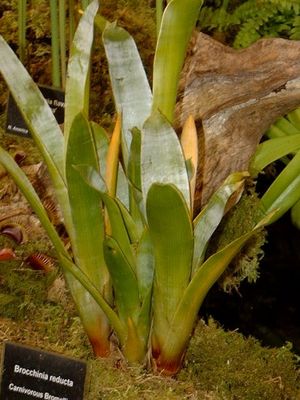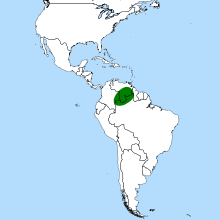Brocchinia reducta
| Brocchinia reducta | ||||||||||||
|---|---|---|---|---|---|---|---|---|---|---|---|---|

Brocchinia reducta |
||||||||||||
| Systematics | ||||||||||||
|
||||||||||||
| Scientific name | ||||||||||||
| Brocchinia reducta | ||||||||||||
| Baker |
Brocchinia reducta is a species of the genus Brocchinia inthe bromeliad family (Bromeliaceae). It is the only carnivorous plant (carnivorous plant) among the bromeliads. It is endemic to the south of the Orinoco in the Gran Sabana on the peaks of some tepuis in southern Venezuela and northwestern Guyana .
description
Habitus
Like all Brocchinia species, it grows terrestrially in dense cushions. Brocchinia reducta is a perennial , herbaceous plant that can reach heights of 30 to 50 (maximum to 60) cm with inflorescence. It forms a weak root system. It is a funnel bromeliad, also called cistern bromeliad, the leaves are densely packed on a compressed stem axis and form a relatively watertight, narrow funnel (the cistern), in which they collect water from precipitation. This collected water allows them to survive dry periods and nutrients collected in the water are absorbed through the leaves.
leaf
The smooth-edged, yellowish to light green, oblong-linear leaves are about 5 centimeters wide with a length of up to 45 centimeters at half length. They stand stiffly upright, are bluntly rounded at the end and have a spiked tip, their surface is smooth.
Inflorescence, flowers and fruit
The upright in the center of the leaf rosette inflorescence stem is slender, terete, up to 60 centimeters high and located him several small, egg-shaped bracts (bracts). The racemose inflorescence is loosely branched.
The short-stalked flowers are radial symmetry , threefold and just under 5 millimeters long. The three petals are white.
The cylindrical capsule fruits contain many elongated, airworthy seeds.
ecology
Communities
The funnels of bromeliads are also a habitat for other organisms. Living things such as algae , protozoa and mosquito larvae find their habitat here. As commensals, there are spiders that weave their webs into the tube opening and thus catch prey drawn by the plant. In their funnels of Brocchinia reducta there is occasionally found as an aquatic epiphyte Utricularia humboldtii , the largest of all water hose species , a unique combination in which the trap of one carnivorous plant has become the habitat of another carnivorous plant species. The dead organisms and the excretions of the animals that live in the water supply of the funnel bromeliads are converted into plant-available nutrients and absorbed through the leaves with the help of suction scales.
Carnivory
Brocchinia reducta is the only bromeliad species that has developed into a carnivorous plant (carnivorous plant). In the tubular cisterns, in which water collects, substances are excreted through glands at the base of the leaves; large plants can contain up to two liters of liquid. The faint scent of the liquid itself (which disappears with age), the smell of rotting plant material that accumulates in the funnel, and a special kind of mimicry : your UV pattern, one for insects but not for humans, serves to attract insects The visible, ultraviolet markings on the leaf are identical to those of the sump pitcher , a carnivore that secrete nectar to attract prey and with which the species often shares locations and competes for prey.
Above the cistern area, the leaves of the plants are provided with glands that secrete a wax . This wax is important for catching prey in two ways: On the one hand, it serves as a coating that makes the leaves smooth. An insect that lands on them inevitably slips into the inside of the funnel of the plant. At the same time, however, the wax also sticks to the legs of the insects and sticks them together, preventing the prey from escaping. For this very purpose, there is also a downward-facing hair in the lower part of the leaves. The captured animals are mostly made up of fire ants , but also flies , mites , mosquitoes , springtails , beetles , spiders , wasps and bees . The quantities and ranges of prey of small and large individuals differ significantly, while smaller specimens catch more and more diverse prey.
For a long time it was assumed that, despite this relatively complex trapping device, Brocchinia reducta does not digest its prey with self-produced enzymes, but rather with digestion in the extremely acidic liquid ( pH 2.8 to 3) (as with some other precarnivores) by special, in the Cistern liquid living bacterial cultures would be carried out. In 2005, however, Bartosz Płachno from the University of Krakow detected phosphatase activity in the digestive glands of Brocchinia reducta , so that this species is to be regarded as carnivorous in the strict sense. The nutrients released by the dissolution of the prey and converted into plant-available ions are then absorbed into the leaf by the suction scales.
distribution
Brocchinia reducta is endemic south of the Orinoco in the Gran Sabana , a Venezuelan white sand savannah and on the peaks of some Tepuis in southern Venezuela and northwestern Guyana at altitudes of 500 to 2900 meters.
Climate in the distribution area
The climate data clearly shows that there is a dry season from mid-November to early March, although the total precipitation is relatively high at around 1600 mm.
It should be noted, however, that the climatic conditions on the Tepuis differ drastically from those measured here on the plain. There the temperature differences between day and night are more pronounced, the temperatures are generally lower, the solar radiation is higher and due to constant fog and rain it is wetter than on the plain, even if rainwater is not stored because there is hardly any soil and the water runs off immediately above ground.
| Santa Elena de Uairen | |||||||||||||
|---|---|---|---|---|---|---|---|---|---|---|---|---|---|
| month | January | February | March | April | May | June | July | August | September | October | November | December | year |
| [mm] | 64 | 45 | 90 | 171 | 203 | 252 | 219 | 163 | 95 | 103 | 119 | 84 | 1608 |
| [° C] | 21.5 | 21.9 | 22.3 | 22.1 | 21.5 | 21.0 | 20.8 | 20.9 | 21.2 | 21.4 | 21.6 | 21.2 | 21.5 |
Location description
Brocchinia reducta colonizes sandy, very acidic and extremely nutrient-poor locations ( habitats ), which is why, like almost all plant species in such habitats, it is dependent on having additional sources of nutrients.
On the one hand there are open locations on the plain in sandy swamps, on the other hand they can be found on some tepuis. There it often occurs together with the sump pitcher garden Heliamphora heterodoxa and Heliamphora nutans , as well as sundew species, trap traps and water hoses . The locations are almost never shaded by larger plants (shrubs or trees).
literature
- John G. Baker : On four new Bromeliads and a new Stegolepis from British Guiana. In: The Journal of Botany, British and Foreign. Vol. 20 = NS Vol. 11, 1882, ZDB -ID 410519-9 , pp. 329-331, here p. 331 .
- Wilhelm Barthlott , Stefan Porembski, Rüdiger Seine, Inge Theisen: Carnivores. Biology and culture of carnivorous plants. Ulmer, Stuttgart 2004, ISBN 3-8001-4144-2 .
- Guido Braem: Carnivorous Plants. Species and culture. 2nd, revised edition. Droemer Knaur, Munich, 2002, ISBN 3-426-66762-2 .
- Jorge M. Gonzalez, Klaus Jaffe, Fabian Michelangeli: Competition for Prey Between the Carnivorous Bromeliaceae Brocchinia reducta and Sarraceneacea Heliamphora nutans. In: Biotropica. Vol. 23, No. 4, Part B, 1991, ISSN 0006-3606 , pp. 602-604, JSTOR 2388398 .
- Klaus Neuhaus: Microevolutive Development of Carnivory in the Bromeliacee Brocchinia reducta? In: The bromeliad. 3, 1995, ISSN 0724-0155 , pp. 69-77.
- Bartosz J. Płachno, Andrzej Jankun: Phosphatase Activity in Glandular Structures of Carnivorous Plant Traps. In: XVII IBC 2005. = XVII International Botanical Congress. Vienna, Austria, Europe. 100 Years after the II IBC in Vienna 1905. Abstracts. sn, Vienna 2005, p. 510, P1716, ( digital copy (PDF; 7.61 MB) ).
- Werner Rauh : Bromeliads. Tillandsia and other bromeliads worthy of culture. 3rd, revised and expanded edition. Eugen Ulmer, Stuttgart 1990, ISBN 3-8001-6371-3 , p. 412.
- JH Frank: Carnivorous bromeliads , 1996 at Bromeliadbiota . (The "carnivorous" species of the Bromeliaceae)

